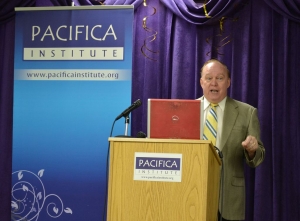Prof. John Reinard gave a lecture addressing the theme of Intercultural communication competence and how can we really understand each other at the Pacifica Institute in Orange County. What are the abilities needed to perform effectively and appropriately when interacting with others who are linguistically and culturally different from oneself?
Prof. Reainrd started the lecture by outlining to the audience as to who would care about international communication.
• Prof. Reinard stated, “[the] US Army research institute tries to make the world safe through the information gathered on different cultures and then training people on those customs. With safety, they can create peace.” Other notable organizations who engage in international communication research include: McDonalds (with its 10 international training centers in 5 countries), Motorola University, and the Rover group. In a truly epiphanous moment, Prof. Reinard reveleaed, “Altogether, these four have spent $20 billion trying to work on international communication to educate people and avoid mistakes and offences.”
Prof. Reinard then went on to talk more about communicative research. He told the audience about the three faces of such communication:
o Language proficiency: formal and informal/ slang language
o Regional experience: from others and ourselves
o Cross cultural competence: adaptations to appropriateness
The main goal is for these faces to eventually merge together.
The research that was presented was done by Geert Hofstede, who took different approaches of culture and compared it to countries all over the world. In this presentation, six different countries were being compared through the power distance, individualism, masculinity, uncertainty and on occasion long or short term orientation. The six countries were Turkey, Mexico, China, Austria, France, and America.
While studying effective cross cultural communication researchers learned that cultures differ in the following key ways:
Power Distance: Different statuses and classes. “High level of concern or respect for people in different statuses” which basically is respect for people in power.
Individualism or collectivism: is the public concerned with the self (I or Me) which would be the individualism or concerned with the whole group (we or us) which would be the collectivism. If there was a high number in IDV that means there is more concern for the individual, but when this number drops then it would be more concern for collectivism.
Masculinity/Femininity: if there is a high MAS then males are viewed as fighters and then women are the nurturers. But if there is a low MAS that means that males are can be viewed as nurturing as well.
Uncertainty Avoidance: gaining information to reduce uncertainty.
Long-term or short-term orientation: how society approaches the statuses in their countries. This section shows If their view on progress is short or long term.
What the researchers found in their data collection is outlined below:
Countries PDI IDV MAS UAI LTO
Turkey 66 37 45 85 N/A
Mexico 81 30 69 82 N/A
China 80 20 66 40 118
Austria 54 46 95 92 80
France 11 55 79 70 N/A
America 40 91 62 46 29
From this data, we can tell a lot about the characteristics of these six countries. The examples used explained how a diplomat or businessman or woman could use this information to their benefit. For instance, a Turkish diplomat going into a meeting with someone from China would view this information and notice the power distance and long term orientation to be high. With China being a communist country, one should already expect low individualism and a higher value for collectivism. With this said, the data reveals that China values their people in power so the Turk would address them as being of higher statues and present their meeting to be beneficial to China in the long term aspect. Taking another scenario, data shows that Americans are high in Individualism along with their uncertainty avoidance. So the Turkish representative would address the matters presented to be beneficial to the American because it would reduce uncertainty along with being of great importance and value individually. These are just some examples that were presented through this data that was collected by Hofstede research.
Prof. Reinard then moved on to talk about the competence skills necessary to enable such communication:
• Self-awareness: knowing what you are
• Knowledge of other cultures and customs
• Empathy for other people (motivation)
• Self confidence
Prof. Reinard closed the lecture with an interesting observation on confusions over pauses and eye contact. Some cultures find pauses awkward such as Americans while others find it a part of the conversation such as the Japanese. In addition, in certain cultures, making eye contact with a superior such as a teacher is found to be rude and belittling and disrespect. It is viewed as saying they are at the same level as the teacher, while in the American society, eye contact is needed to show that the students are paying attention. These are just a few examples of customs that can be viewed differently and cause confusion.

